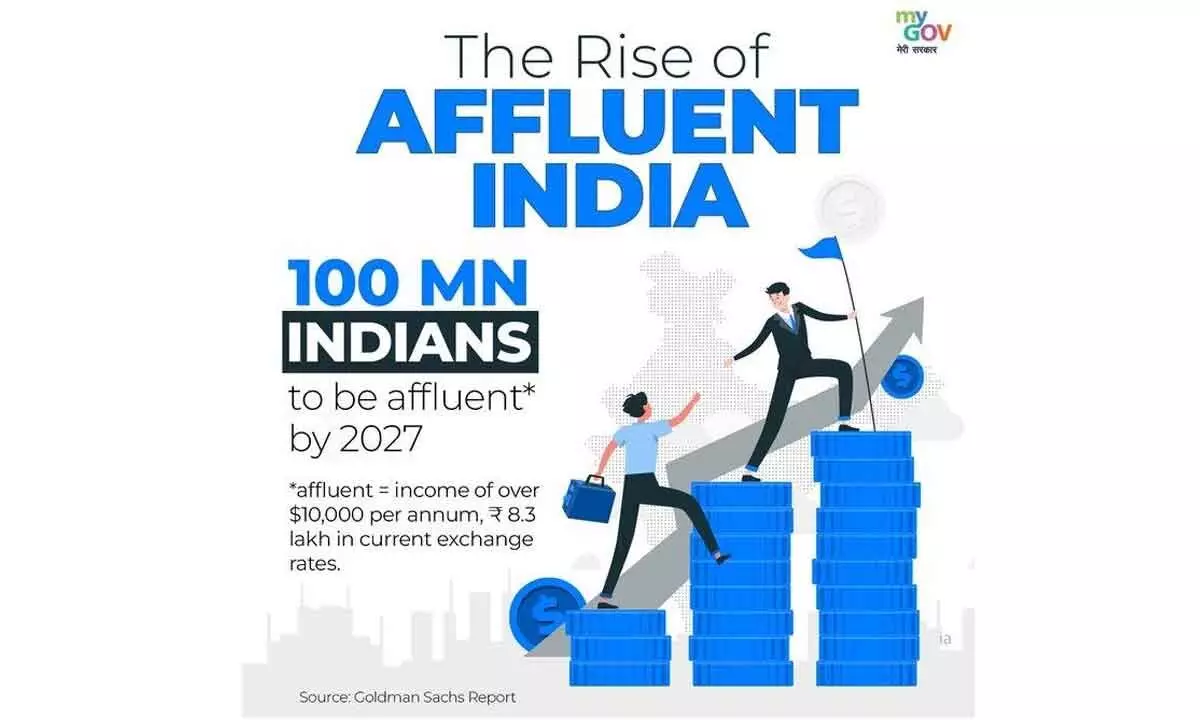Affluent Indians propel country’s buying power
The surge has translated into an increase in assets like equities, gold, and property
image for illustrative purpose

In a report titled 'The Rise of Affluent India', Goldman Sachs predicts that the number of affluent Indians, defined as those with an annual income exceeding $10,000 (approximately Rs. 8.3 lakh at current exchange rates) is set to soar from the current 60 million to a staggering 100 million by 2027. This projection hints at a significant paradigm shift in consumer behaviour and wealth creation, with far-reaching implications for various sectors, ranging from luxury goods and the stock market to automobiles and jewelry.
To comprehend the magnitude of this projection, consider that only 14 countries globally have populations exceeding 100 million. The exponential growth of this affluent class, constituting just about four per cent of the current working population, is anticipated to have a profound impact on India's economic landscape. The report highlights a remarkable 12% compounded annual growth in this affluence class between 2019 and 2023, a stark contrast to the mere one per cent increase in the overall population during the same period.
This surge in affluence has translated into a substantial increase in financial and physical assets, encompassing equities, gold, and property. Goldman Sachs points to a noteworthy 2.8 times increase in demat accounts, reaching 114 million in 2023, signalling a surge in stock ownership and mutual fund investments. The value of gold held by Indians has surged by an impressive 63%, reaching $1.8 trillion between 2019 and 2023.
Financial analysts suggest that the sharp increase in demand for premium products spans various industries, including fast-moving consumer goods (FMCG), footwear, fashion, passenger vehicles, and two-wheelers. Companies focusing on top-income consumption have experienced enhanced performance, with notable success observed in the jewellery, travel, premium retail, and healthcare sectors.
This affluence boom has not only impacted consumer behaviour but has also altered company product portfolios. As an example, Nestle has outpaced Hindustan Unilever, while HUL's premium portfolio has exhibited faster growth than its overall revenue. Indicators such as credit card ownership have surged by 80% since FY19, and credit card spending has witnessed a remarkable 250% increase during the same period, serving as a proxy for consumption by the affluent class.
Crucially, Goldman Sachs analysts assert that this surge in top-end consumption is not a transient trend. Despite initial speculation that the divergence in consumption patterns was a result of Covid-19 restrictions, the report argues that the phenomenon persisted even after the full lifting of restrictions in early 2022. The sustained growth rates, even 24 months post-restriction, indicate that the boom in 'Affluent India' is rooted in fundamental economic shifts rather than pandemic-related factors.
While the report paints a promising picture of India's economic landscape, it does not shy away from highlighting potential risks. Changes in the government's tax policy, corrections in stock and gold prices, and increased competition from new market entrants pose challenges that could impact the trajectory of this affluence surge.
The prediction by Goldman Sachs paints a dynamic picture of India's evolving economic landscape. The profound impact on various sectors, coupled with sustained growth trends, positions 'Affluent India' as a force to be reckoned with in the global economic arena.
According to an analysis by State Bank of India (SBI), about one-fifth (19.5 per cent) of micro firms (with annual turnover less than Rs. five crore) that were active throughout the 2013-21 period were able to move to higher income categories over this period.
“Out of these, 4.8 per cent firms have transitioned themselves into small firms (annual turnover up to Rs. 50 crore), around 6.1 per cent firms transitioned into medium-sized firms (annual turnover up to Rs. 100 crore), and around 9.3 per cent firms are transitioned into large-sized firms (annual turnover higher than Rs. 100 crore),” the report said.
The December data of the Reserve Bank of India in its ‘Trends and Progress in Banking’ report confirmed that small and medium enterprises (SMEs) were getting larger. It showed that the average size of the loans taken by these companies had grown from Rs. 4.2 lakh in 2020-21 to Rs. 10.6 lakh in 2022-23.
“This reveals integration of MSME units with larger value chains as PLI (Production-Linked Incentive) activity is getting momentum,” the report said and added “This will increase the ability of MSME units to raise capital through (non-bank) debt markets.”
Overall, SBI’s calculations show that the weighted average annual income of those filing income tax returns has risen from Rs. 3.1 lakh in FY12 to Rs. 11.6 lakh by FY21. It predicts that the weighted average income for FY22 will be in the range of Rs. 12.5-13 lakh.

